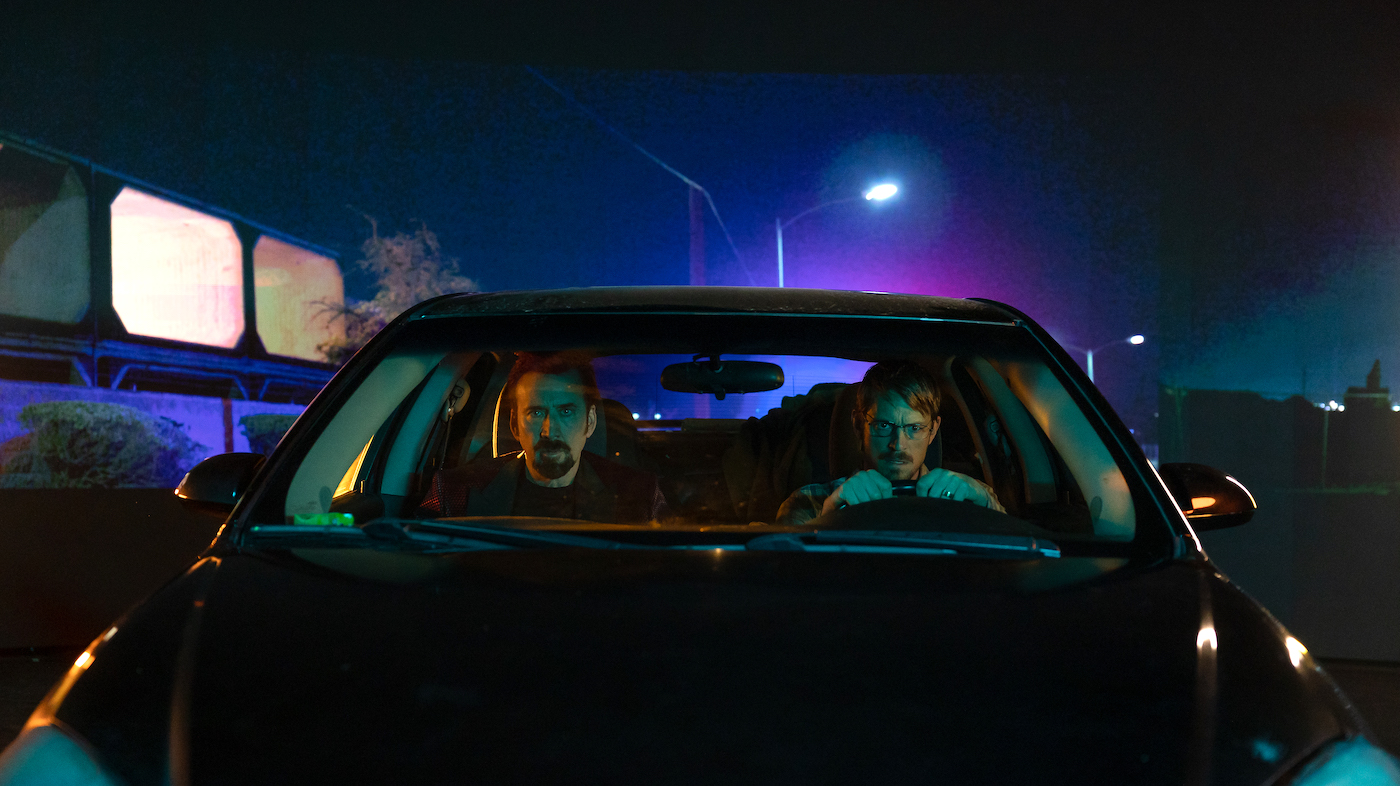Nicolas Cage “leaves” Las Vegas in a big way, thanks to ICG Director of Photography Steve Holleran and his facility with the LED Volume (on an indie budget, no less!)
by Kevin Martin / Photos/Screengrabs Courtesy of Steve Holleran/RLJE Films
“The greatest trick the Devil ever pulled was convincing the world he didn’t exist.”
This statement, generally attributed to Baudelaire, is voiced by a character in The Usual Suspects who is most definitely not who he appears to be. While Sympathy For the Devil, a summer theatrical release from RLJE Films, delivers an eerie psychological study in terror, it also explores Baudelaire’s famous dictum in even more surprising ways. A driver (Joel Kinnaman), trying to be with his wife when she delivers their baby, runs afoul of an unwanted, seemingly-mad passenger (Nicolas Cage), who proceeds to upend his night while forcing him to confront his own dark past.
Director Yuval Adler’s award-winning Bethlehem, followed by The Operative and The Secrets We Keep – also starring Kinnaman – demonstrated a flair for character-driven suspense, and his commitment to the Devil script was maintained until he was able to secure financing as well as ideal lead actors. An important factor in making the film was the decision to capture roughly half of it within an LED Volume at VU Studios in Las Vegas, where the film was ultimately shot on a 28-day schedule after being uprooted from Georgia.
We talked with Devil’s creative principals, led by Director of Photography Steve Holleran, whose willingness to take big creative and technological risks was highlighted in ICG Magazine’s January 2023 Sundance Issue. That includes a 90-minute indie feature shot as a oner – at night – and the Sony Pictures Entertainment early 2023 release Missing, an international thriller shot from the perspective of laptops, security cameras and cell phones, with much of the action staged for 9 × 16 aspect ratio.

Prep/Platework
Director of Photography Steve Holleran: The movie was greenlit a few months before I came on, and out of my four weeks of prep, over half were spent on getting the necessary plates shot. There was no time to generate storyboards; the director and I worked out a shot list together, looking at older films for visual references. I wanted to keep the tension up through camera movement, either on a dolly or through whip pans and other dynamics like slow push-ins, but very little handheld. We were also considering other aesthetic matters, like the nature of truth and fiction with our two main characters and how to twist perceptions about that through visual choices. The story turns perceptions and themes on their head at various points, for instance who is good and who is evil, so we developed visual cues and accents that worked with the subjectiveness of the story. I varied color choices throughout, using primaries like you’d expect in areas with street stoplights, but distressing them a bit. After visiting the Neon Museum in Las Vegas, I also tried to feature a whole range of in-between colors, which is something you do see a lot of in Vegas. It helped create a visual statement of how things were always in flux between these two characters and even within the driver himself and the questions about truth and what really happened in the past.
There were several parameters needing to be addressed well in advance of shooting. The first big issue was figuring out how we were going to deal with getting plates for all the driving scenes – in a movie where so much of the action took place in a car at night, often on dark desert roads. That meant extreme low-light conditions, but the plates had to be bright enough so we could show the car moving through various environments, from the center of Vegas, traveling to the outskirts towards Henderson, and on through the desert. Since we needed all of that shot up front, the plate shoot became its own mini-production. Since there weren’t any companies that could provide low-light plate work at the necessary resolution, I decided to shoot all of the plates myself.
1st AC/Camera Operator Dennis Bosnjakovic: I work in L.A. and Las Vegas year-round on commercials and movies, so I know crews in both cities. The majority of our crew was local to Las Vegas and came from recommendations. We prepped out of Panavision Woodland Hills in late July 2022. For the main part of the shoot, we used very fast large-format Panaspeed LF’s that were tuned at Panavision with Guy McVicker to create things like custom halation, spherical aberration influence, and lifted blacks.
Holleran: I chose those lenses because they were fast and lightweight, plus they could be customized into a set that matched my need for halation and blooming. Sony and Panavision provided us with the VENICE 2 cameras and the Rialto to facilitate shots inside the Volume car. Then there was settling on a camera for plate capture, which became an important conversation with various plate experts, the Volume crew and Production. While several cameras are capable of 16K/360 degrees, none of those work well enough in low light, which became clear once we put the material up in the Volume; the imagery just fell apart. So I turned to Sony’s a7S system I’d used on a film that was essentially a low-light 90-minute oner. We took a step up from that camera to the Sony Alpha III, using eight cameras in an array on the vehicle to get the necessary high-res, low-light plate material, using the 12,800 ISO setting and Zeiss Batis 18-millimeter prime lenses.
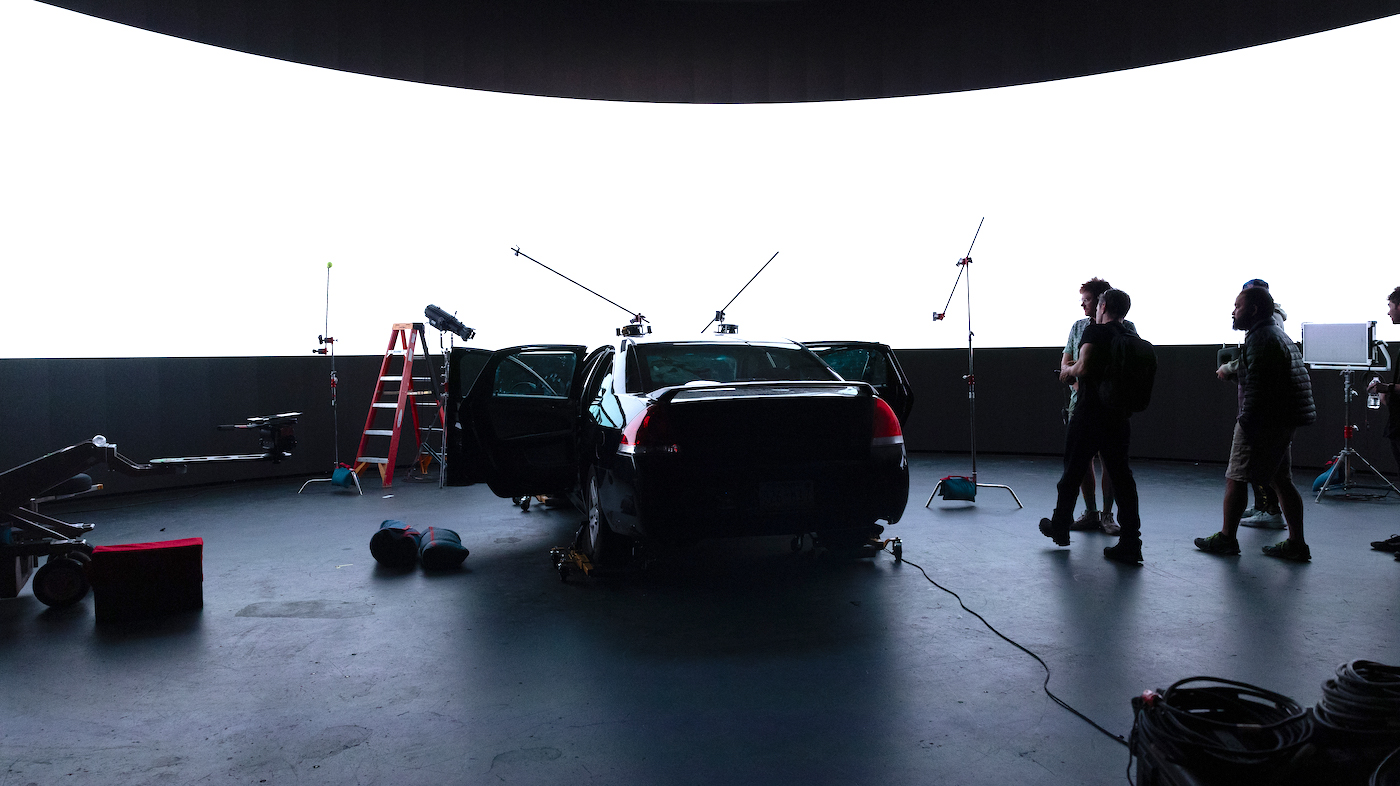
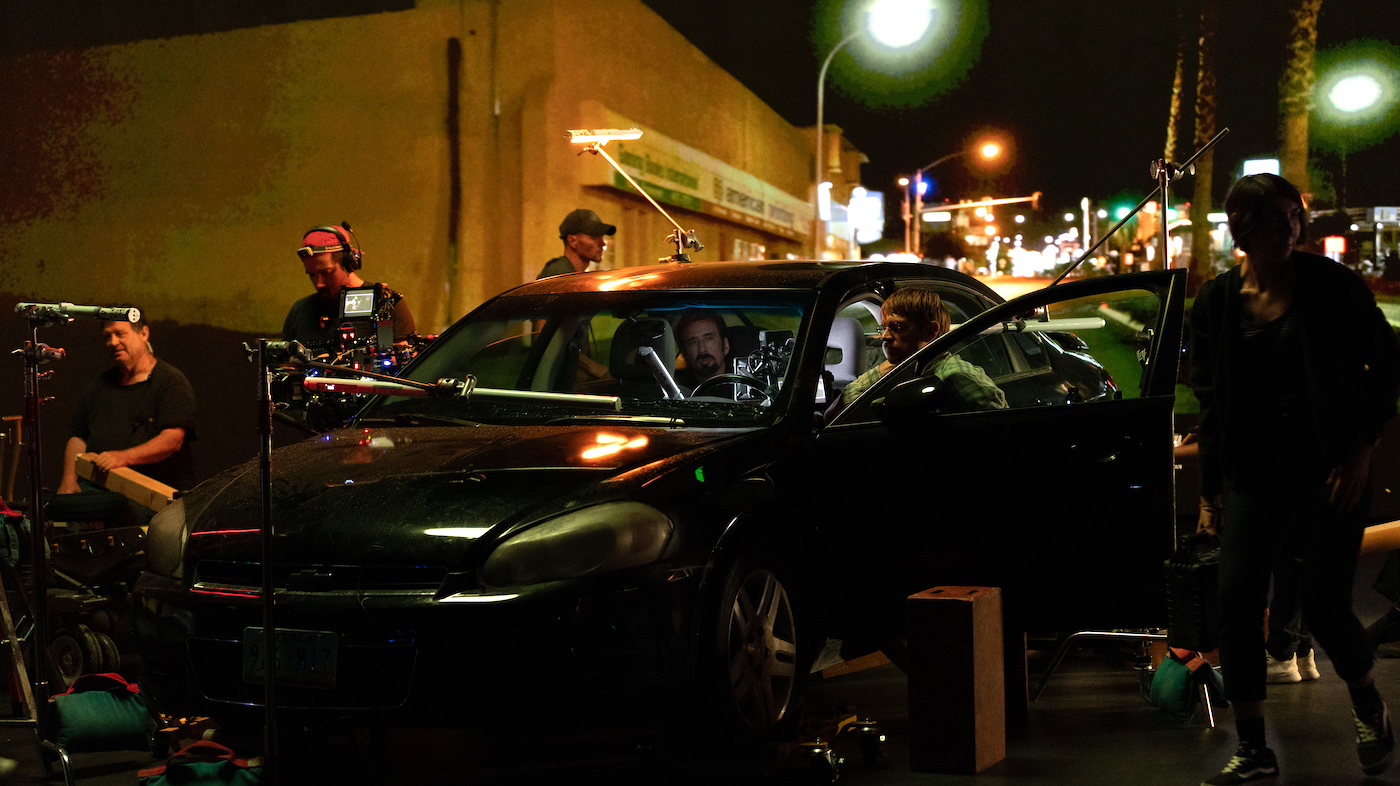
Bosnjakovic: The grip department came up with a rig that let us shoot almost 360 degrees on the car. The cameras were hooked up to external recorders to get the highest quality out of the sensor.
Holleran: There was a 20 percent overlap between each of the seven cameras in the array: two at angles out the back, two at angles from the back aiming left and right, and three from the front. The eighth was designed to capture rooftop reflections, which turned out to be very important because they’d get projected from the ceiling screen in the Volume to get us interactives that moved across the roof and windshield and hood.
Chief Lighting Technician Gregory Doi, Jr.: We used a wide array of lights to help set up the areas we were shooting. In Vegas, there are a lot of background lights that helped create depth and layers behind our actors. But most of our locations did not have much practical lighting; a lot of our exterior sets had just a couple of streetlights, so we used Condors with an HMI light and an ARRI S360 SkyPanel to provide backlight or both a hard edge and a soft glow to backgrounds.


Dining on Ashes
Holleran: There were specific action beats during the drive, including a moment when the driver bails out of the car, plus another scene when they are pulled over by a cop. Since those events needed to be staged, we had to have actors present for the plate shoot. This required a lot of coordination to make sure everything lined up in look, movement, and performance. Sometimes we’d shoot the actual car exterior out on the real road, while other times we’d only be shooting the vehicle weeks later, within the Volume.
We had two weeks of nights out in the desert for exterior non-car scenes. Unfortunately, there was unexpected monsoon weather – casinos got flooded! – so we just happened to have a schedule lined up with four weeks of the heaviest rain I’ve ever seen. The desert turned green. We’d lose four hours per day to rain. Then we had a big build at an abandoned diner near Henderson that the art department built up into the restaurant set you see. There were old practical neons on the wall inside, so we had to ND [neutral density] and gel them and dial out the rolling shutter.
Doi: We added LED fixtures to supplement the diner sources. Since we were shooting in the summer months, we didn’t have a long night period, so we would normally start the day with a full blackout tent and shoot looking towards the back of the restaurant. When the sky finally turned dark, the grips would remove the tent and we were able to turn around and look out the front windows. The area where the diner was located was very desolate, so we also used lighting outside the front of the building to create car headlight effects, which helped to extend the background further. We used [B&M] Mac Tech 12-light Mini Dino fixtures for the fire flame effects at the exterior of the diner. Incandescent bulbs have a much better decay and provide a more realistic firelight.
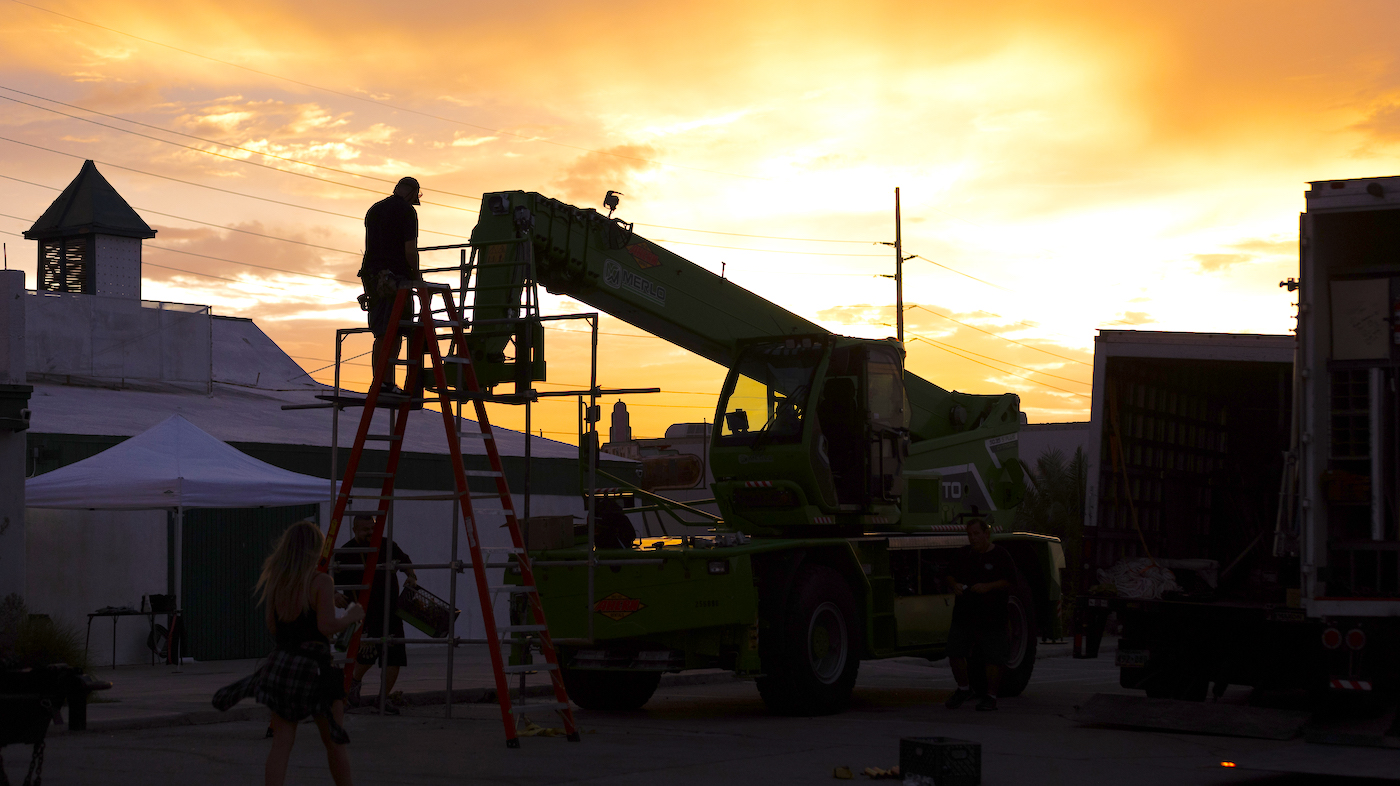
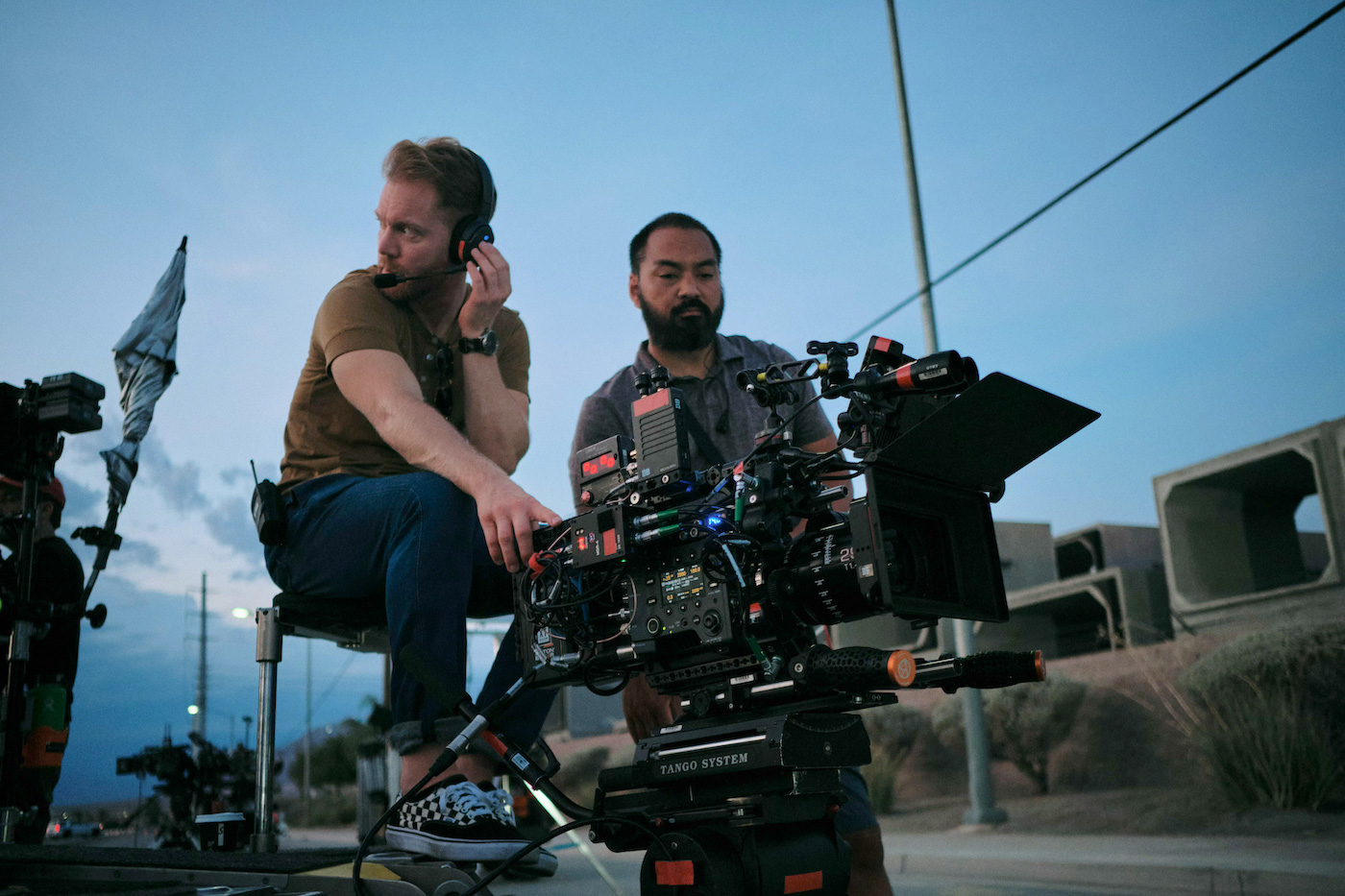
Holleran: The last exterior shoot we did, right after the diner, had us outside a canyon. I was running with the camera, then fell and shattered my collarbone, right before the Volume work was going to start. So, with all the bad weather, my injury was one more setback in a whole stretch of hellish things that had us wondering, “Is this movie cursed?” [ Laughs.] Smack in the middle of all this was a Union strike flipping the film when we were two-thirds of the way through. The film was SAG and DGA, but not IATSE, so that caught IATSE’s attention very quickly.
Western Region Business Representative Ryan Sullivan: The crew on this did an amazing job of coming together to fight for what was fair. The department heads were united in assisting their fellow crew and making sure information was explained thoroughly. This was straightforward organizing in the sense the crew knew from the start that this should be an IATSE project. It took some time, but eventually, the producers realized this as well. Las Vegas is a great place to film, with experienced crews that will make sure productions are well taken care of; Production should do the same for the crews. A crew working under an IATSE contract that gives them health and pension benefits works a lot happier and better than a crew without. Independent productions like this ask a lot of their crews and only a professional, union team could have pulled this job off.
Bosnjakovic: Regarding the work stoppage, it didn’t last very long. We knew what the budget of the movie was because we did some digging around with the publicly available documents from the state government’s tax incentives and they already had budgeted for a “union contingency.” We all wanted to get healthcare hours because of the amount of time we were dedicating to the project. I feel the healthcare hours and the banked hours concept needs to be overhauled because for those many folks who don’t work in L.A. all the time on bigger projects, they don’t get the benefit of MPI, which only benefits the few that solely work on union productions. We’re seeing many productions intentionally steer clear of being union so as not to provide any benefits to crews, regardless if they are movies, live events or specialty events. That’s a problem.
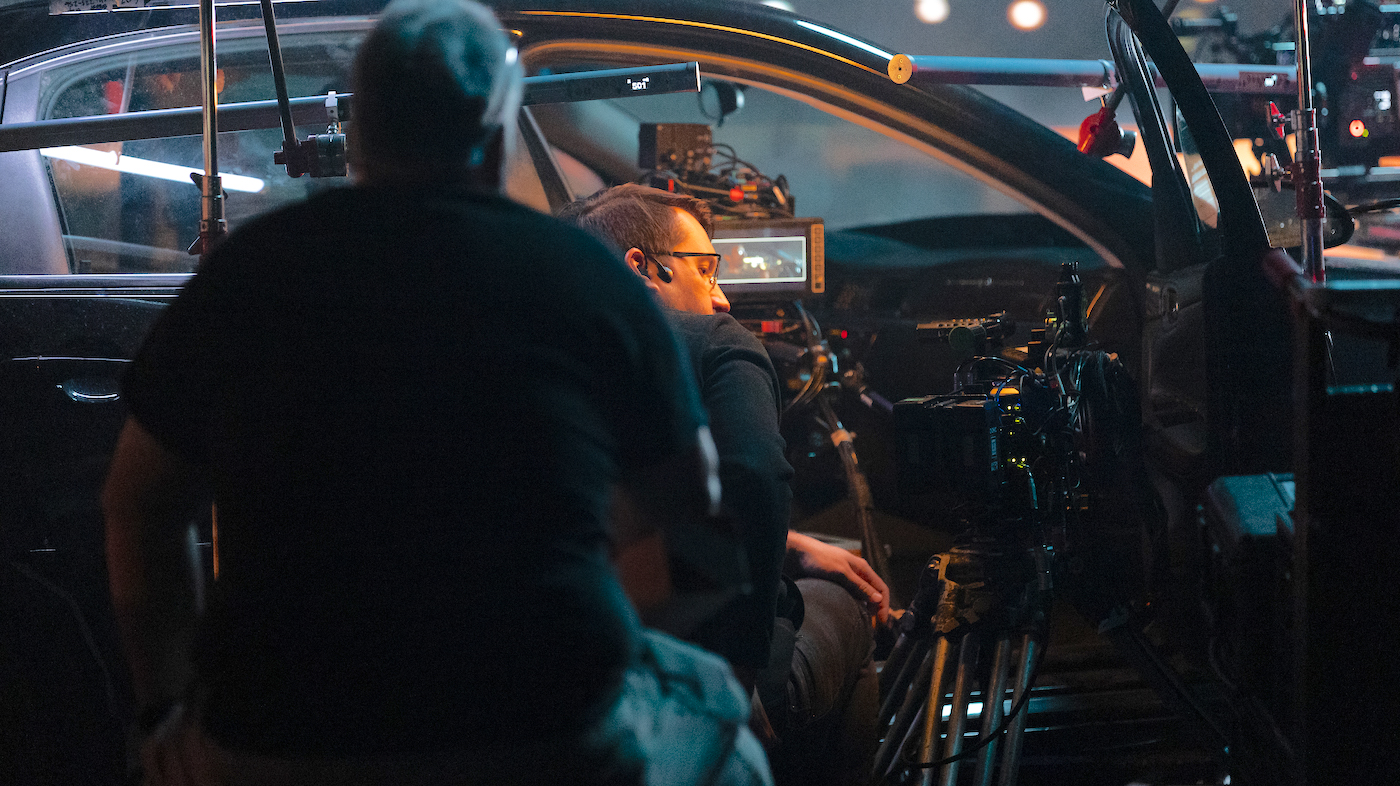
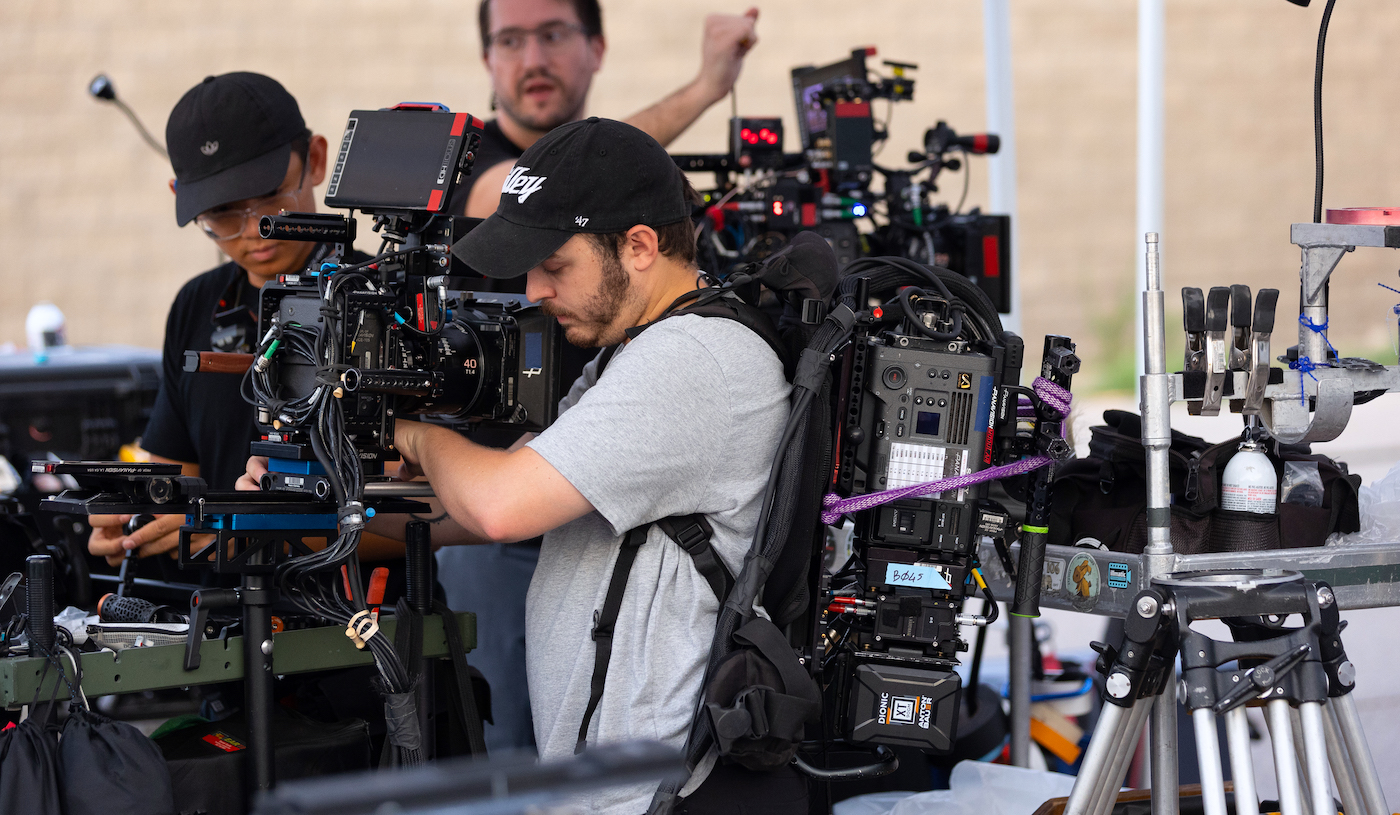
The Wall
Holleran: The Vū Studios stage was a 130-foot J-shaped Volume that gave us a real sense of dimension as well as scale. There was a ton of debugging because nobody had put this type of low-light material up on that wall before. Besides brightness, getting things colored properly for secondary capture was essential, which meant tweaking the display for the right refresh rates – often digital cameras don’t always play back just right on LED, so it took a lot of testing. We ended up building a custom workflow with the team at Vū, who were very game to help. It was pretty intense in terms of data processing and management, with eight cameras at 4K, the highest data rate possible. On the plate side, we had a whole team running playback so the director and I could decide which plates would go where, and at what angle the car needed to be relative to the wall.
Bosnjakovic: We shot tests on the Volume stage and changed the base ISO setting on the VENICE from 2500 to 500 because we had everything controlled in the Volume. Most of the movie was at a wide aperture with the background blurred out. So that, plus having the car and camera far away, was enough to deter any moiré effects. I think one of the challenges was keeping the correct parallax with the new camera angle. We weren’t using the Unreal Engine, which can make real-time calculations; we were using video plates. We had to adjust the height of the background until it was at a level that felt realistic to the height of the car and the camera position. Being on comms helped, so we would make real-time adjustments with the Volume technician.
Colorist Joel Ides: Steve shot RAW, and nothing was baked into the dailies. The only LUT’s facilitated for production were used on the Volume stage for the background driving plates. I gave Steve about six options for exposure so he could decide which one worked best on the day. These LUT’s, made in Resolve, were for the most part close to the S-Log 3 to Rec.709 camera transform, with just a bit more contrast. We did do some color tests once production was rolling, so Steve could see results tilted toward the final look of the film as he was shooting.
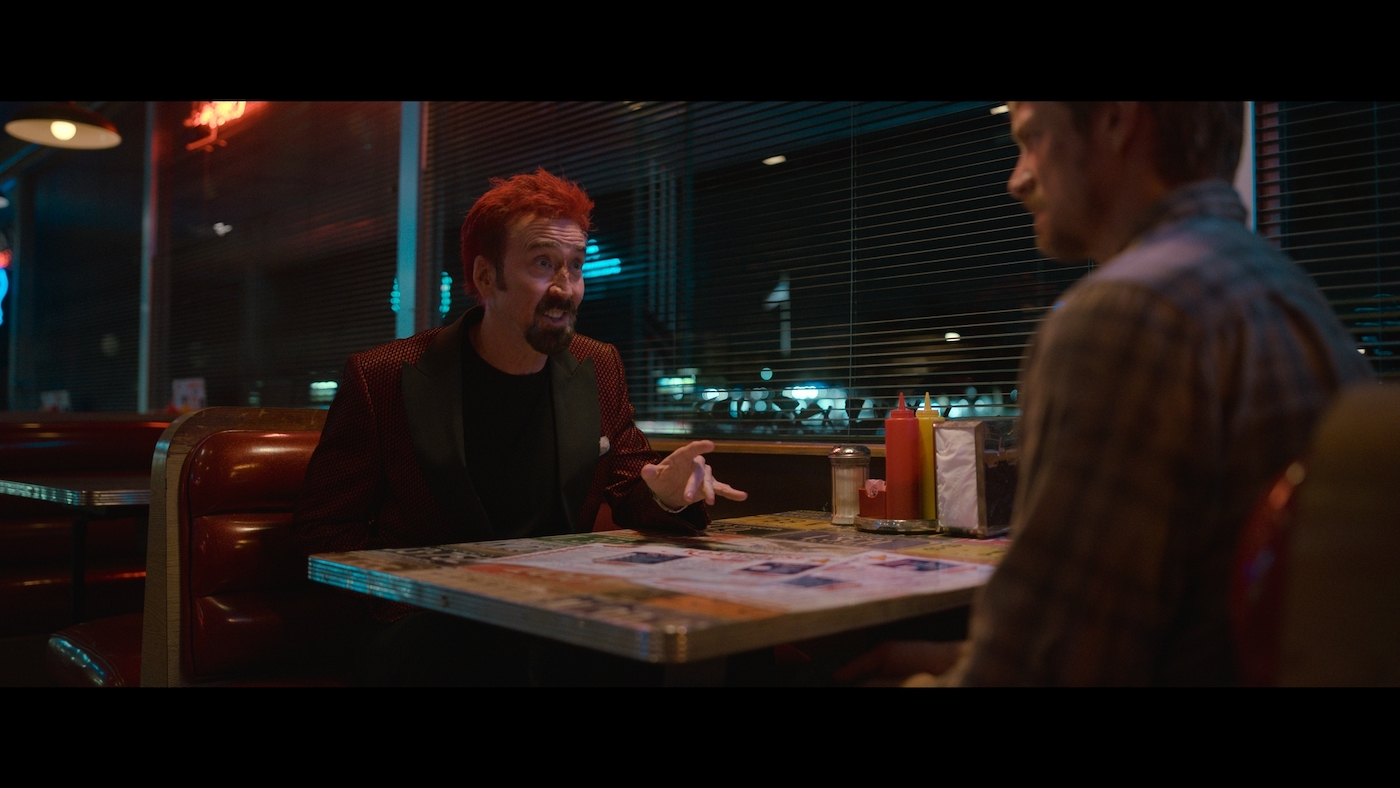
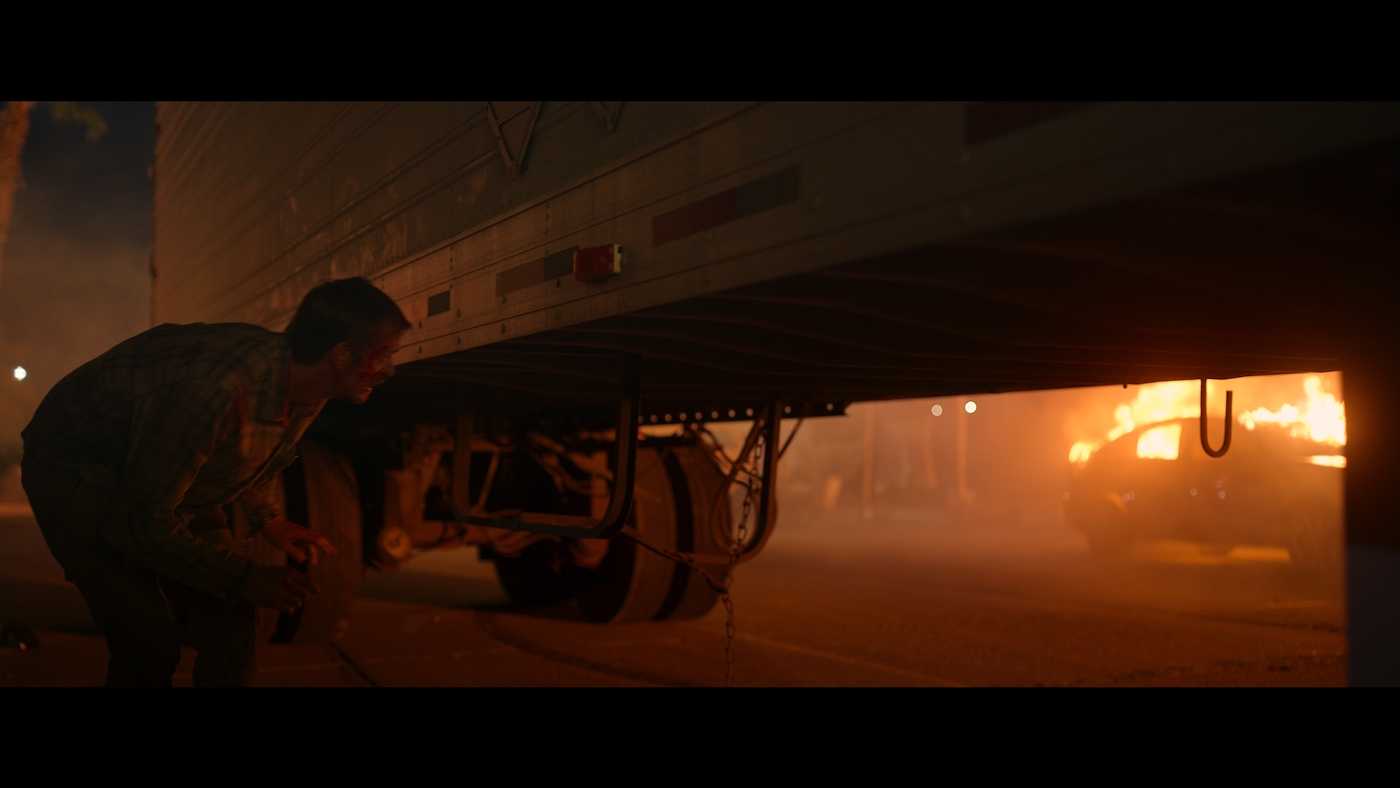
Holleran: You can get a lot of reflections from the wall as well as the ceiling part of the Volume. It helped with transitions in the story, because if they were on a highway in Vegas you’d have yellow security lights overhead, and if they pulled off you would go into mercury vapor or neons. This was very important on the dash window, in particular, because if you don’t have light from the dash, your eye doesn’t buy the driving, so that was critical. Greg Doi and I had recorded the location’s colors during the plate shoot and mapped those to the Titans so they could display matching strobing patterns that emphasized a sense of movement.
Doi: The majority of lighting in the Volume was done with Creamsource Vortex, Aputure Nova, and Astera Titan tubes. We used a Blackout lighting console that made cues and light chases simple and convenient with the control of an iPad that I could carry around with me on set. Another great tool that we used in the Volume was software to create shapes on the Volume walls. We were able to create any size, shape and color, then place those anywhere on the wall. This was particularly useful when we wanted to add a light in an area that would be in the shot; we were able to create a “virtual” lighting fixture.
Holleran: To sell the idea that the driving scenes were real, I wanted to see as much of the world around them as I could. The approach was simple when it came to coverage and aggressive when it came to picking angles. If you chose just the right angle, you could capture a really wide shot looking down and in from above the car hood. You could show a whole lot of the car exterior as well as the road; you just had to be sure to not show the wheels and blow the illusion of movement. We always ran two cameras [operated initially by Holleran till he was injured, plus Dennis Scully] on dollies or sliders or rigged inside the car, with grips and camera operators both contributing to the sense of motion. That component of practical vehicle movement – like what you’d get if the camera was mounted on the hood or inside the vehicle, with some rattle and vibration – could have been done in post but would have been expensive.
Bosnjakovic: When Steve had his accident, I stepped up to operate. He would view footage remotely while trying to coordinate surgery. We created a camera shake effect on set that gave the intuitive feel of a realistic driving shot – as if you had a camera sitting on a car rig and it was going over bumps, et cetera. Steve and Yuval liked the natural effect it gave to the dialogue scenes. I listened to Nic and Joel’s dialogue to know when to minimize or add more shake to the scene. One process of filmmaking and collaboration that’s most enjoyable is doing the dance of the camera with talent movements. As for focusing tools, I had my Preston system that worked beautifully with the Panavision ecosystem. They made us custom cables of different lengths to embed in the loom that was connected to the Rialto so it was lightweight and easy to maneuver inside and around the car. I can’t think of another FIZ system that would have given us that type of versatility and a wide range of options for builds. B-Camera had Preston and Light Ranger systems; it was a very seamless experience.
Doi: There are so many scenes in the car that locked actors into a space with very little body movement, so lighting faces was critical to capturing the wide range of emotions during these scenes. We created a bunch of different looks with color schemes and used the versatility of RGB LED lights to change tones and colors while still maintaining a proper level of exposure. Sometimes it would be as simple as fading a key light from a tungsten color to an amber-orange or green; other times we would dim the key light down to zero and at the same moment use a LED Leko to wipe over the actors’ faces to create a passing street light effect.
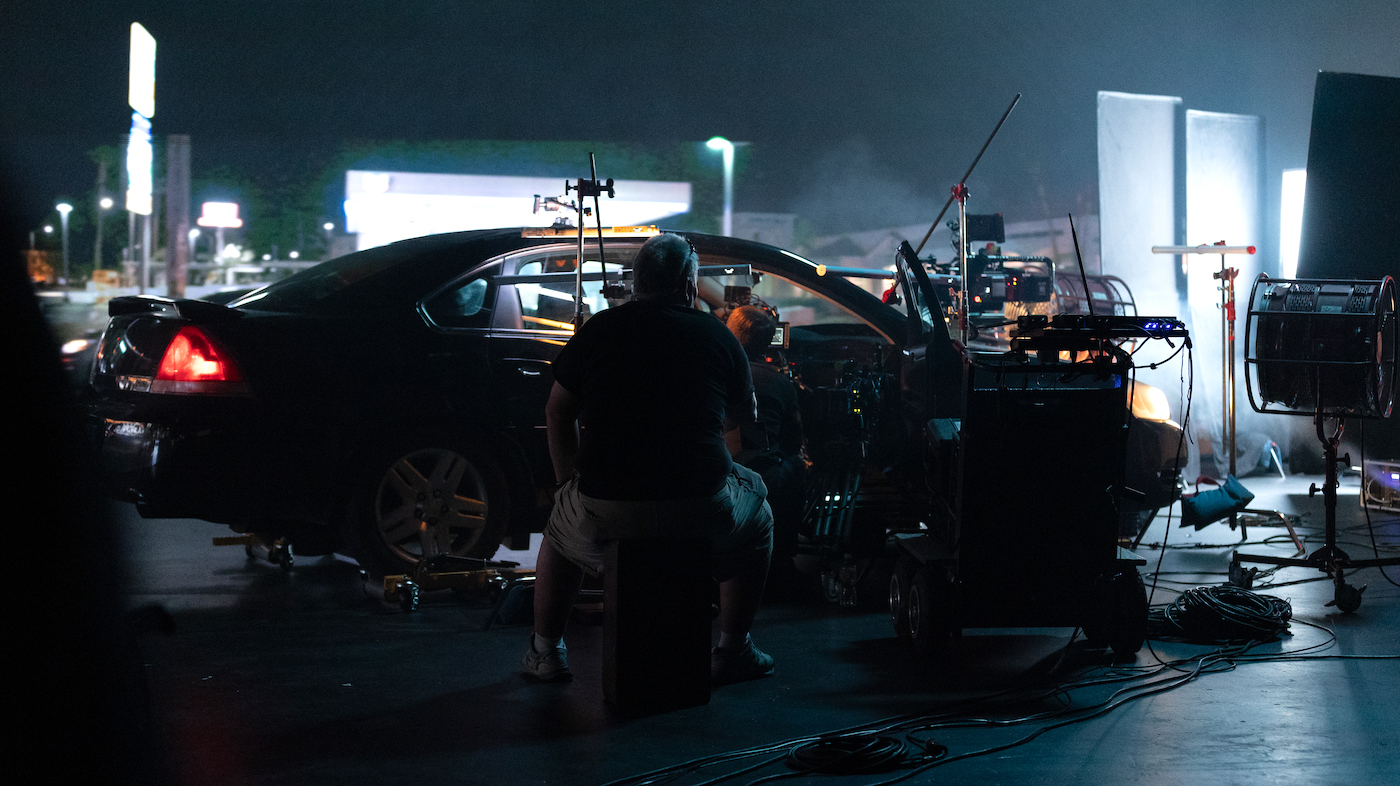
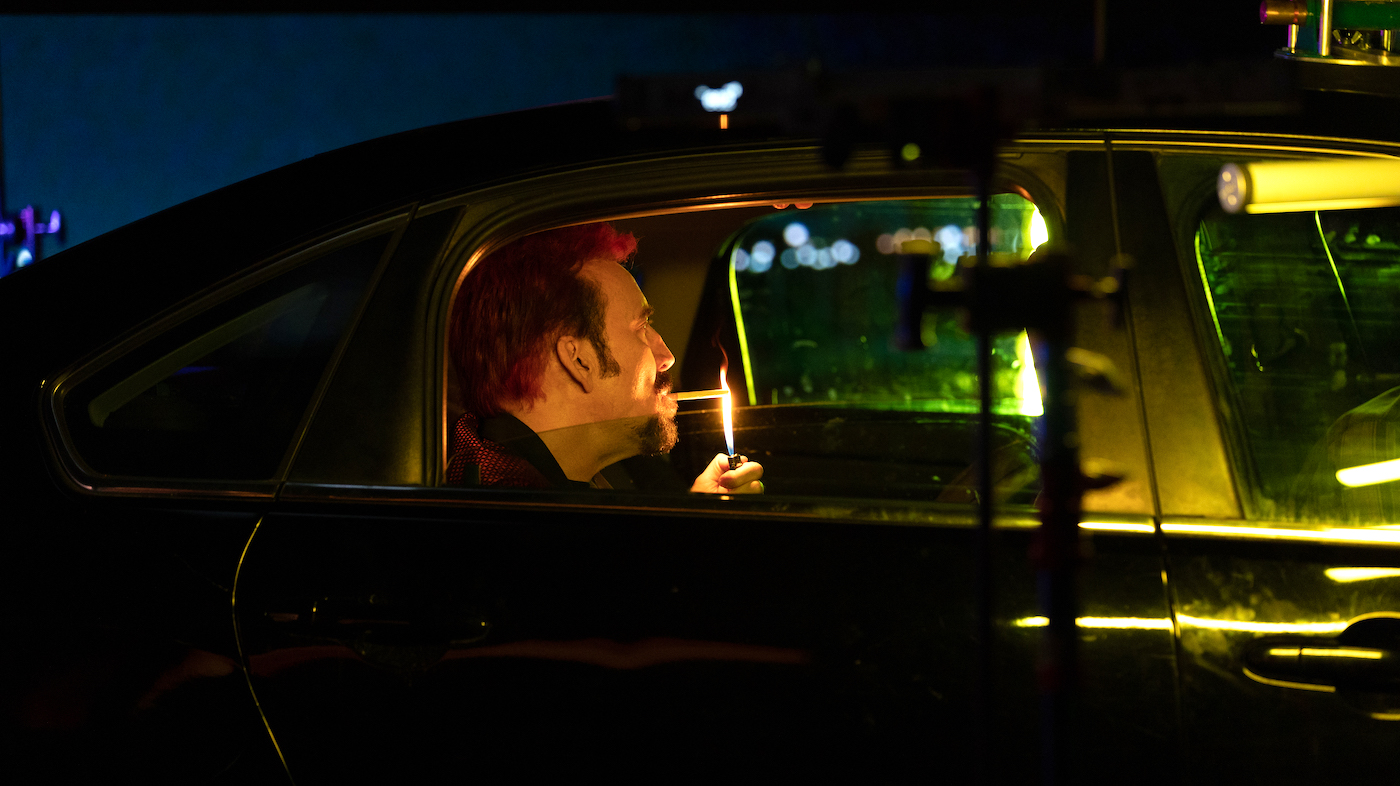
Endgame
Ides: The film was graded at Anarchy Post in Glendale, a great resource for indie filmmakers. I’ve been with them as a freelancer for almost 10 years. The main look of the film was crafted in the color grading suite. Steve Holleran was very hands-on, in the room for maybe 70 percent of the grade, with Yuval being pretty deferential to Steve’s choices. Ultimately all of Steve’s production choices are in the final image; his placement of colors and lighting ratios were the backbones of the grade, but the end result is quite shifted from the OG, resulting in darker contrast, a shift from blues to teals, toned down reds and desaturated neons and a considerable amount of shaping with windows. The most notable differences were in the diner and the fire sequence, the latter of which we leaned hard into the warmth.
I used DaVinci Resolve and ACES color science with a node-based workflow. I find it gives me the most flexibility with any image. I like the way printer lights feel and operate in this setup, and I can get repeatable, consistent results fairly quickly with a primary color correction. Curves and keys can be pushed a lot harder, and the results are cleaner too, helping to avoid undesirable textures and added noise or color clipping. I work on a lot of indie films that don’t have time for color pre-pro.
VFX Supervisor Dan Gaud: I did most of the VFX work, so I supervised myself. There are around 200 VFX shots in there, from small things like stabilizing shots to more complicated background removals, fire, and gore effects.
Ides: With the linear ACES EXR workflow, it was easy for me to match the VFX with my grade and make easy fixes if necessary. Using ACES gets me to an image they are familiar with and gives me the option of creating a different aesthetic completely, if that’s what is required. A third-party plug-in, Neat Video, was used for noise reduction and worked fantastic.
Holleran: Honestly, there wasn’t ever an easy day on this one. [Laughs.] That can feel frustrating at times, but as a filmmaker, dealing with challenges and resolving situations is very rewarding as well. There’s the push to be better, so it was a double-edged experience. We knew within the first week we were getting scenes with Joel and Nic that would grab audiences by the lapels and shake them up, and that kind of magic motivated me to match those performances with the cinematography.
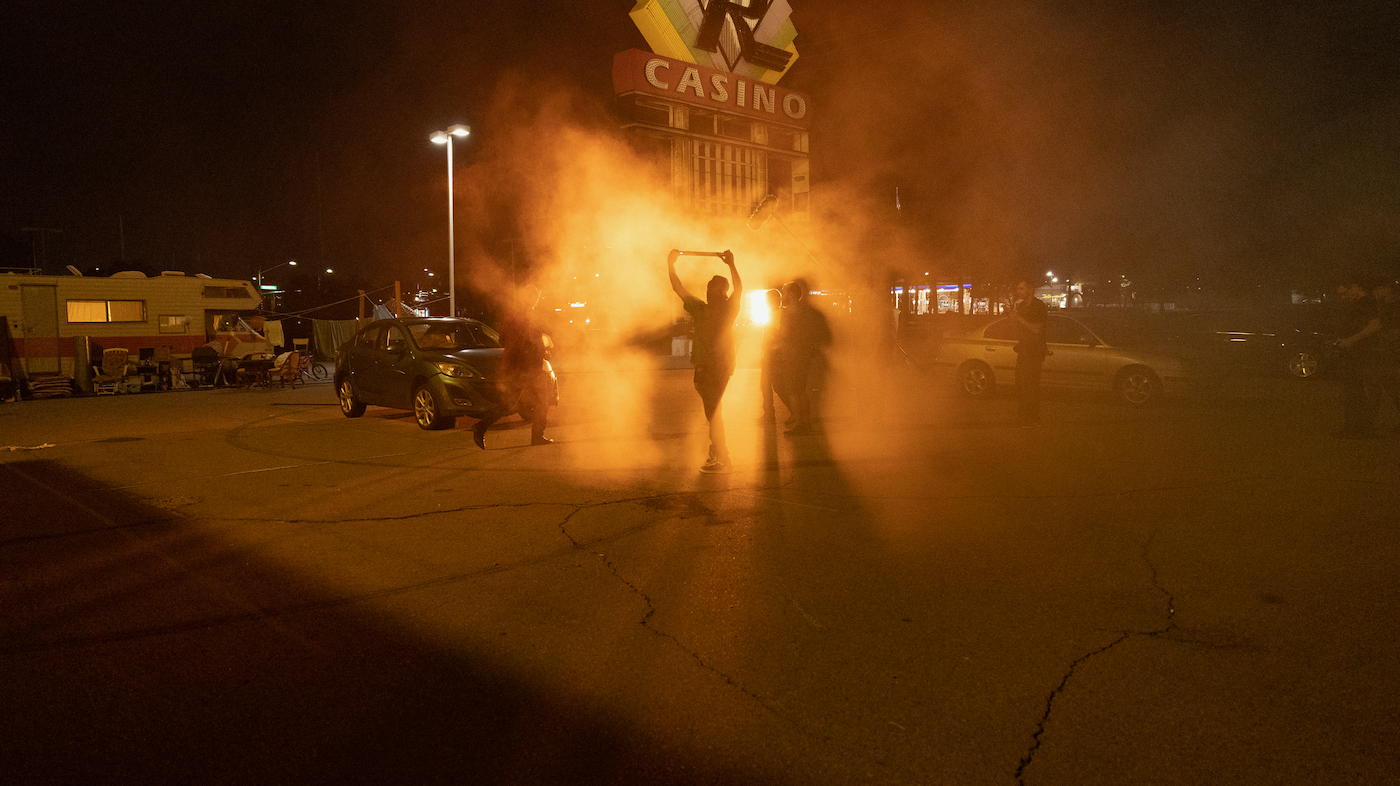
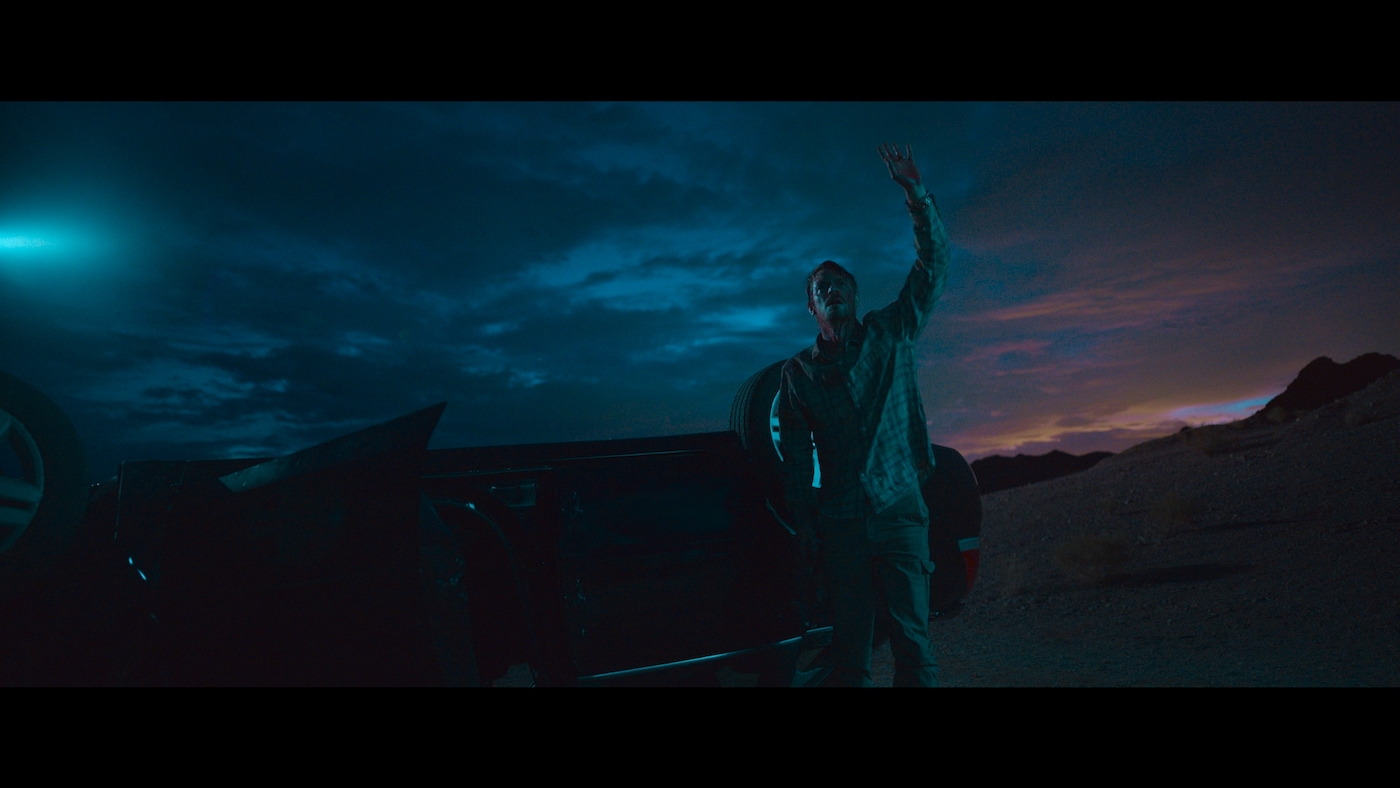
Local 600 Crew: Sympathy for the Devil
Director of Photography: Steven Holleran
A-Camera 1st AC: Denis Bosnjakovic
A-Camera 2nd AC Day Player: Dimitri Agnos
B-Camera Operator: Dennis Scully
B-Camera 1st AC: Hayden Warner
